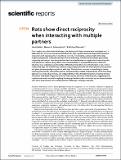Files in this item
Rats show direct reciprocity when interacting with multiple partners
Item metadata
| dc.contributor.author | Kettler, Nina | |
| dc.contributor.author | Schweinfurth, Manon Karin | |
| dc.contributor.author | Taborsky, Michael | |
| dc.date.accessioned | 2021-02-10T09:30:19Z | |
| dc.date.available | 2021-02-10T09:30:19Z | |
| dc.date.issued | 2021-02-05 | |
| dc.identifier | 272416757 | |
| dc.identifier | 995e00f9-41a6-4b5a-baf8-a03f1e39377d | |
| dc.identifier | 85100536186 | |
| dc.identifier | 000617534800003 | |
| dc.identifier.citation | Kettler , N , Schweinfurth , M K & Taborsky , M 2021 , ' Rats show direct reciprocity when interacting with multiple partners ' , Scientific Reports , vol. 11 , 3228 . https://doi.org/10.1038/s41598-021-82526-4 | en |
| dc.identifier.issn | 2045-2322 | |
| dc.identifier.other | ORCID: /0000-0003-2066-7892/work/88268204 | |
| dc.identifier.uri | https://hdl.handle.net/10023/21398 | |
| dc.description | Funding was provided by the Swiss National Science Foundation grants 31003A_156152 and 31003A 176174 to Michael Taborsky, and P2BEP3 175269 to Manon K. Schweinfurth. | en |
| dc.description.abstract | Direct reciprocity, where individuals apply the decision rule ‘help someone who has helped you’, is believed to be rare in non-human animals due to its high cognitive demands. Especially if previous encounters with several partners need to be correctly remembered, animals might either stop reciprocating favours previously received from an individual, or switch to the simpler generalized reciprocity mechanism. Here we tested the decision rules Norway rats apply when interacting with multiple partners before being able to return received help. In a sequential prisoner’s dilemma situation, focal subjects encountered four different partners that were either helpful or not, on four consecutive days. On the fifth day, the focal subject was paired with one of the previous four partners and given the opportunity to provide it with food. The focal rats returned received help by closely matching the quantity of help their partner had previously provided, independently of the time delay between received and given help, and independently of the ultimate interaction preceding the test. This shows that direct reciprocity is not limited to dyadic situations in Norway rats, suggesting that cognitive demands involved in applying the required decision rules can be met by non-human animals even when they interact with multiple partners differing in helping propensity. | |
| dc.format.extent | 8 | |
| dc.format.extent | 1060926 | |
| dc.language.iso | eng | |
| dc.relation.ispartof | Scientific Reports | en |
| dc.subject | BF Psychology | en |
| dc.subject | DAS | en |
| dc.subject.lcc | BF | en |
| dc.title | Rats show direct reciprocity when interacting with multiple partners | en |
| dc.type | Journal article | en |
| dc.contributor.institution | University of St Andrews. School of Psychology and Neuroscience | en |
| dc.identifier.doi | 10.1038/s41598-021-82526-4 | |
| dc.description.status | Peer reviewed | en |
This item appears in the following Collection(s)
Items in the St Andrews Research Repository are protected by copyright, with all rights reserved, unless otherwise indicated.

